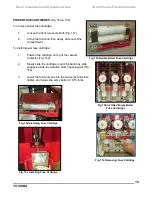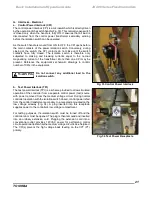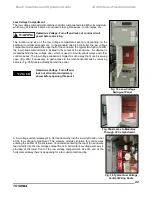
Basic Installation and Operation Guide
JK 400 Series Fixed Controllers
TOSHIBA
14
Electrical Checks
With incoming power isolated and all loads disconnected electrically, the control circuit and other mechanisms
should be exercised to determine that the devices operate properly. An auxiliary source of control power will be
necessary to provide power to the electrical operators.
Electrical shock hazard. Do not touch energized components during a test
using auxiliary power.
The ground fault protection system (if furnished) should be tested in accordance with the instructions furnished with
the device.
An electrical insulation test should be performed to ensure that the controller and associated field wiring are free
from short circuits and grounds. The preferred method is to perform a dielectric test at 2.25 times the nominal
system voltage plus 2000 volts. This should be done phase-to-ground, phase-to-phase, and phase-to-neutral (if
applicable), with all switches, contactors and circuit breakers opened. Disconnect any devices which may have
limited dielectric strength and that are not intended for this test.
The light or buzzer, or both, used to indicate breakdown should be calibrated to indicate failure with an output
current between 1.5 and 2.0 milliamperes per 1000 volts applied.
Hazardous voltages are present during dielectric testing that can result in
serious injury or death. High potential test should be performed only by
qualified personnel. Refer to safety instructions provided with the test
equipment.
All devices must be set to their normal or OFF position before energizing incoming
power.
WARNING
WARNING
















































